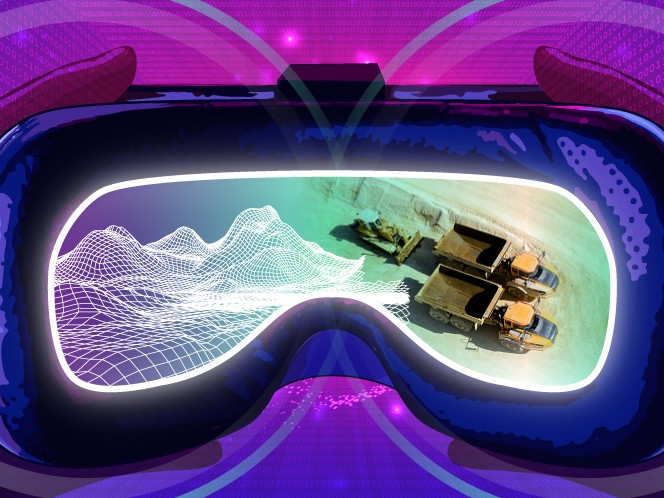The mining industry levels up: how the industrial metaverse will power Mining 4.0
Posted: November 15, 2024

Who says video games are bad for society?
Gamers, tell your grandmas: technologies that arose from the gaming industry[1]—like virtual reality, digital avatars, and immersive simulations—are now revolutionizing mining. These tools, developed to navigate fantasy worlds and battle virtual villains, are now increasingly implemented to make real-world mining safer, more sustainable, and more profitable.
In a sector as critical and dangerous as mining, these gains are game-changers. Today, we’re exploring how these technologies are transforming the industry—and why the industrial metaverse may be the most practical and impactful use of the metaverse concept, far beyond social media or entertainment.
Our Industrial Life
Get your bi-weekly newsletter sharing fresh perspectives on complicated issues, new technology, and open questions shaping our industrial world.
What is the industrial metaverse?
Let’s say you’re a maintenance engineer at a copper mine, tasked with inspecting a chute to ensure its walls aren’t degraded. Normally, your job would require your presence at the mine itself, no questions asked. You’d be manually collecting diagnostic data, and facing physical risks, from equipment malfunctions to the potential collapse of the chute. On top of that, accurately identifying the true remaining life of an aged asset is also not always so straightforward.
But picture this instead: you’re in your home office, sipping chamomile tea, navigating a virtual replica of the chute on your computer. This digital twin mirrors every detail, updated in real time with data from diagnostic tools. You can inspect the chute virtually, spot wear issues, and address them early—all without setting foot on site.
Digital twins are increasingly used in the mining industry, offering a level of real-time insight that was once a pipe dream. They now enhance safety and efficiency, allowing engineers to monitor equipment remotely and proactively address issues before they escalate.[2] But the next phase of Mining 4.0 is just emerging: the industrial metaverse.
The industrial metaverse is conceptualized as an immersive, interconnected digital environment that mirrors the entire ecosystem of a mine, allowing intuitive interactions and real-time insights of the physical mine as a coherent whole. While digital twins in their existing state are effective at simulating specific processes or devices, their potential becomes more fully realized when unified within this broader platform. A digital twin lets you monitor data, but the industrial metaverse immerses you in that data.
By consolidating a mine’s disparate digital twins, the industrial metaverse delivers comprehensive, bigger-picture operational insights. It achieves this by integrating advanced technologies such as virtual reality, extended reality, cloud computing, and machine learning. Beyond mining, the industrial metaverse could be an immersive simulation of a factory, a transportation network, or even an entire city.
How are mines currently using the industrial metaverse?
Just imagine donning a VR headset to step into the mine virtually, like a character in a video game. Your digital avatar can collaborate in real time with colleagues around the world, examining the chute's integrity, testing repairs in a risk-free simulation, and visualizing the results—all before anyone sets foot on site. All the while, you can still sip tea at your desk.
Sound like breathless hypothesizing? It isn’t—mines and engineering departments are already incorporating metaverse technologies into their workflows, to great results.[3] Chile-based company Minverso, which boasts the world’s first mining metaverse, provides mines with the ability to remotely interact with assets and collaborate in an immersive virtual environment.
A significant advantage this early stage of the industrial metaverse offers is the ability to provide immersive virtual training. By entering the metaverse as it exists already, new engineers and technicians can learn to operate complex machinery and practice emergency scenarios, all risk-free. They can make mistakes, experiment with repairs, and build confidence without facing the real dangers of a mining site. These new tools cultivate a more robust safety-first culture, empowering workers to more effectively navigate one of the world’s most challenging industries.
What does the future of the industrial metaverse look like?
The hype may be strong, as the significant capital[4][5] thrown towards metaverse tech suggests. But it’s key to keep in mind that the technologies are still in their early days, with future applications that have yet to be even imagined—or a lot of promise that may peter out. Memories are still fresh of how Facebook’s metaverse failed to gain legs.
Nevertheless, concrete uses of the industrial metaverse continue to emerge—such as more sustainable, cost-effective collaboration between diverse stakeholders. The metaverse not only allows technical teams to collaborate offsite and thereby conserve resources, but could also open doors for non-technical team members to participate by offering new user experiences that enable intuitive interactions with mining processes.[6]
Exploration efforts may also improve with metaverse technologies. Critical minerals are in dwindling supply, and are becoming more difficult to discover, access, and process.[7] VR platforms can assist industry workers with visualizing and analyzing the mountains of complex data gathered in mining processes. The immersive, 3D representation of spatial data can also help them understand what to expect once they start to explore assets, far beyond what current tools on a desktop can offer.[8]
Meta’s metaverse famously hit rock bottom when rolled out as a social platform nobody needed. But in mining and other essential industries, the industrial metaverse shows promise in unearthing real-world value.
References:
[1] https://venturebeat.com/business/nvidia-gtc-how-to-build-the-industrial-metaverse/ “All the interesting things that have come about in technology in recent decades started in gaming first. Voice over IP, social media, digital currencies, all these things were concepts in the gaming world well before they became mainstream. Simulation of 3D worlds has been around in video games now for more than 20 years. Now that’s becoming applicable–we’re applying that to many non-gaming purposes.”
[2] https://www.mining-technology.com/features/digital-twins-predictive-maintenance/?cf-view
[3] https://attheu.utah.edu/facultystaff/immersive-vr-trains-miners-for-the-real-world/
[4] https://www.technologyreview.com/2022/12/05/1063828/the-industrial-metaverse-a-game-changer-for-operational-technology/
[5] https://attheu.utah.edu/facultystaff/immersive-vr-trains-miners-for-the-real-world/
[6]https://venturebeat.com/business/nvidia-gtc-how-to-build-the-industrial-metaverse/
[7] https://www.sciencedirect.com/science/article/pii/S0301420722006651
[8] https://www.youtube.com/watch?v=CgP31J5w9Ng&ab_channel=UniversityofSouthAustralia